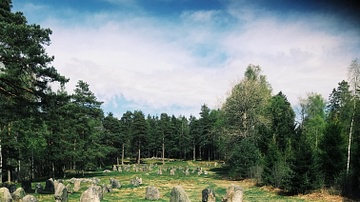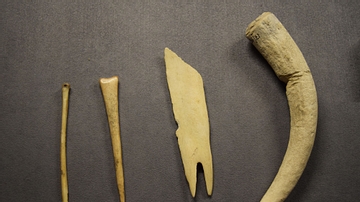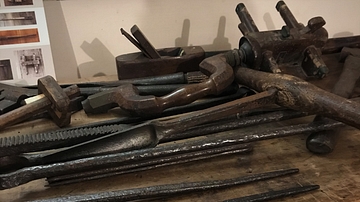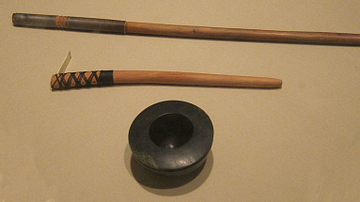Search
Search Results

Article
Exploring Norways' Forgotten Stone Circles & Petroglyphs
Right outside the cities of Fredrikstad and Sarpsborg in South-East Norway, there are two archaeological, intriguing and beautiful sites, the Hunnfelt, a monument consisting of several stone circles and burial sites, and the Begbyfelt, a...

Image
Samoan Tattooist Using Traditional Tools
A Samoan tattooist using the traditional tools to place a tatau (tattoo) on a man's back. The methods and tools were also used in New Zealand by the Maori. This photograph was taken c. 1895 CE by Thomas Andrew (1855-1939 CE).

Article
The Tizoc Stone
The Tizoc Stone is a huge stone cylinder from the Aztec capital of Tenochtitlan which depicts a sun-disk on its flat upper surface and carries a frieze around its outer edge showing Aztec warriors and the Aztec king Tizoc, whose reign from...

Image
Obsidian used for Prehistoric Japanese Tools
This piece of obsidian dates from the Paleolithic period or c. 18000 BCE, and it was uncovered in Engarau-cho on Japan's Hokkaido island. It helped prehistoric Japanese people in making stone tools. (Tokyo National Museum)

Image
Eneolithic Tools from Armenia
These Eneolithic tools are made of stone or bone. They come from what is present-day Armenia, and they date from the 5th-4th century BCE. (Metsamor Historical-Archaeological Museum-Reserve, Taronik, Armenia)

Image
Hand Tools
Hand and blacksmith tools on display at Te Waimate Mission, Bay of Islands, New Zealand. The mission house was constructed in 1832 CE. This photo was taken in November 2019.

Image
Traditional Pacific Island Tattoo Tools
Instruments for traditional Pacific Island tattoos: hāhau (tapping stick) made of ulei wood, moli (tattoo tool) made of wood and bone, and apu paʻu (ink bowl), made of jade. Date unknown.

Definition
Homo Rudolfensis
Homo rudolfensis is an early human species that lived in East Africa between c. 2.5 and 1.8 million years ago. It is known from a handful of skull, jaw and teeth fragments that remind alternatingly of Homo or of Australopithecus and that...

Video
Carving Marble with Traditional Tools
Prior to the use of power tools, the same basic implements were used for stone carving for hundreds of years. Many of the sculptor's tools had a variety of functions and could be used at different stages of the carving process. In this video...

Video
The Sun Stone (The Calendar Stone), Aztec
The Sun Stone (or The Calendar Stone), Aztec, reign of Moctezuma II (1502-20), discovered in 1790 at the southeastern edge of the Plaza Mayor (Zocalo) in Mexico City, stone (unfinished), 358 cm diameter x 98 cm depth (Museo Nacional de...